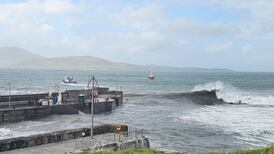Before there was television news there were cinema newsreels – and one of the greatest peacetime stories they ever told was the epic battle to save the Flying Enterprise.
It began on a Christmas Day – and for the next 14 days the sea saga off the south-west coast of Ireland was to grip most of the western world. Every day, the radio and newspaper reports became longer, more detailed and more excited as everyone – from small boys to grandparents – kept watch to learn the fate of the stricken freighter Flying Enterprise and its heroic skipper, Capt Kurt Carlsen.
His name alone could have been dreamed up by Hollywood.
The ship that was to inspire such massive coverage was an ordinary 6,700 ton cargo ship that happened to sail into the worst storm to hit the Atlantic in 35 years. It was sailing from Hamburg to New York with 40 crew and nine passengers – and a cargo of pig iron and furniture.
READ MORE
It was 300 miles off Ireland’s southwest coast on Christmas Day when it was hit by a fierce gale. Crew and passengers were tossed violently from side to side. By December 27th the pounding seas caused the freighter to crack right across the deckhouse and down one side. It began to list badly.
Two US Navy vessels rushed to the area. The passengers and crew jumped into the freezing sea and were all safely picked up.
It was then that the 37-year-old Danish-born Capt Kurt Carlsen declared that he was staying with his ship – and the world’s media jumped into action.
The cinema newsreel companies - Pathé News and Movietone being the big two – hired aeroplanes to fly out and find the struggling ship, and audiences soon found themselves watching an unfolding true story more gripping than the main feature film.
The Flying Enterprise was just one of several ships in peril, but soon the headlines began to proclaim: “Lone Captain Stays With His Ship”.
As 1952 dawned the Enterprise remained afloat, though listing worse than ever. By now the aerial pictures showed Carlsen on the deck, the ship looking tiny amid the mountainous waves. Its main engines had stopped. There was little food left on board but the captain laconically reported to the US transporter Golden Eagle that he was dining on currant buns, some beer and Rhine wine. He confessed to being “a little tired” but that otherwise everything was “fine and dandy”.
The American ship later managed to send him coffee, cigarettes and magazines.
His mother, meanwhile, was now being interviewed, saying that her son had always been “a very good boy, but very obstinate”.
The second chapter of the story started on January 2nd when the powerful 1,136 ton tug Turmoil set off from Falmouth to try to tow the ship to safety. Its first mate, Kenneth Dancy was to gain his own slice of fame in the next few days.
On January 4th the newspaper headlines were proclaiming “Tug Now Alongside”. By now no elaboration on those three words was necessary.
The Turmoil made several attempts to get a line on board. Capt Carlsen leaned out precariously as he tried to grasp the line, but to no avail.
Then Kenneth Dancy made his epic leap. The Turmoil had edged as close as possible to the other ship and First Mate Dancy jumped across the gap between them, bringing with him the tow line. The deed was later flashed on millions of cinema screens – where audiences were by this stage queuing to see the newsreels.
Now a hawser could be reeled aboard the Flying Enterprise and it could be towed to shore. But where? Bantry Bay was closer, but the Enterprise’s owners opted for Falmouth in Cornwall. The two ships set out, followed by a flotilla of other craft, and shadowed overhead by planes.
For the next three days they inched closer to Cornwall. Each day’s mileage was reported and avidly read. By now everyone wanted the Flying Enterprise to survive. And it was listing at nearly 80 degrees.
In Falmouth over 300 reporters and cameramen had taken up every available hotel and boarding house. The seafront was swathed in flags and bunting, waiting to greet two storybook heroes.
But on day 13 the towline snapped, and the Enterprise was once more adrift. “Carlsen In Peril”, screamed one headline. The skipper himself said it was “nothing very alarming”, but the Flying Enterprise began to list further. Carlsen and Dancy donned their lifejackets and walked out along the sloping funnel and jumped into the angry waves. They were hauled aboard the Turmoil just before the Enterprise slid below the waves. The saga had lasted 14 days. The ship had been 30 miles off land.
Kurt Carlsen became a world hero. He was feted in London, and flew home to New York via Shannon Airport. He was presented with a lifebuoy from the city of Limerick by lord mayor Stevie Coughlan.
He joked that he was a little nervous facing into his first ever transatlantic flight. And he had good reason – the plane had to turn back to Shannon because of ice on its wings. The planned New York ticker tape parade had to be postponed for a day – but then it rivalled the welcome given to the returning war hero Gen Douglas MacArthur.
Carlsen turned down Hollywood offers for his story, and ignored all other commercial offers. He went back to sea within months at the helm of Flying Enterprise II, and went on sailing until he retired in 1976. He died in October 1989.












